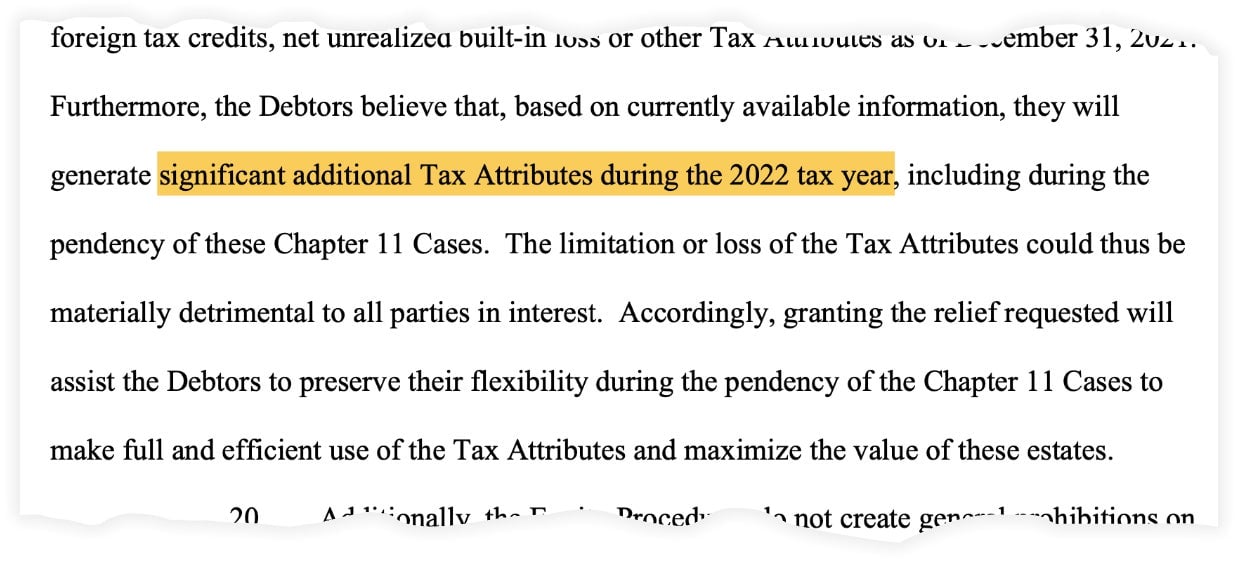Sam Bankman-Fried's other big con was perfectly legal
FTX was wildly profitable, but it claimed billions of dollars in losses on its tax returns. How?

FTX’s best trick was making and losing money at the same time:
- It made money literally, by minting its own cryptocurrency, and then used the now-worthless token to raise real funds.
- It put the real money toward facilitating trades of less-real money, which generated profits whether crypto values went up or down.
- It raised still more cash from venture-capital firms on the premise of an 11-figure valuation that has now gone to zero.
- And it used funds flowing in from customers to finance risky bets, simultaneously losing the money and making profits off the trades.
“Dollars are fungible with each other,” Sam Bankman-Fried, the founder and former CEO of FTX, said recently to explain how money wired to company accounts could b used for more than one purpose. “And so it’s not like there’s this $1 bill over here that you can trace through from start to finish.”
Of course, in properly run companies, you absolutely can trace the flow of funds and avoid using the same dollars twice, fungible as they may be. Bankman-Fried’s empire, encompassing the crypto exchange FTX, hedge fund Alameda Research, and a labyrinth of subsidiaries, was clearly skilled at making dollars multitask. That trick was the source of both its spectacular, five-year rise to the top of the crypto industry and its even more incredible, five-day fall.
It’s also at the heart of fraud charges against Bankman-Fried, who was arrested on Dec. 12 in the Bahamas, where he’s expected to be extradited to the US. He is facing criminal charges of fraud and money laundering. A civil complaint against him by the US Securities and Exchange Commission accused Bankman-Fried of diverting customer funds and lying to investors “from the start.”
But there’s another way in which FTX was able to make and lose money simultaneously, which hasn’t been previously reported. And incredibly enough, this trick was and remains perfectly legal for investments that are subject to US taxes. It allowed FTX to rack up billions of dollars of tax deductions, by losing money, while otherwise running a profitable business.
An enormous loophole
In fact, the tax-avoidance strategy may prove to have generated the only lasting value created by FTX, which put its entire empire into bankruptcy a month ago. Court filings by FTX’s new leadership show the company claimed more than $4.4 billion in federal and state tax deductions, as of the end of 2021, which could be valuable if the company emerges from bankruptcy.

The source of those losses hasn’t been explained, but a review of the public record, supported by interviews with former FTX insiders and accounting experts, points in one clear direction: aggressive use of tax-loss harvesting, leveraging rules that favor crypto investors and corporations to stretch an anodyne practice of traditional finance to the point of absurdity.
Bankman-Fried’s hedge fund Alameda exploited a huge loophole in US tax rules that allows crypto traders to book losses on paper that can be used to offset actual gains. The approach rests on a tax-avoidance strategy so brazen that the US banned its use with stocks and other securities 86 years ago.
The scheme is simple, legal, and widely used by crypto traders ranging from novices on Coinbase to institutional investors like Alameda. Two people familiar with Alameda prior to its collapse, who requested anonymity, said the hedge fund aggressively used strategies like those described here to book losses on paper while also generating profits in real life. Much of this was done with a trading algorithm baked into Alameda’s code, the people said.
How the scheme works
Let’s say you bought one bitcoin for $40,000 at the beginning of this year. Maybe you watched the Super Bowl ads, and came away thinking fortune favors the brave. And it sure felt that way until mid-year, when bitcoin began falling sharply; it now trades around $17,000. But you are still brave and think bitcoin has a bright future, so you commit to maintaining the position long-term.
Here’s the totally legal tax move in the US: Rather than just holding onto your bitcoin for dear life, you sell it at $17,000 and then immediately buy it back. You have realized a $23,000 loss, which can be used to offset other income and lower your taxes. And yet you haven’t lost anything at all, really: You still own one bitcoin, and you can enjoy any future gains from the investment. Meanwhile, you get to pay less in tax and invest the savings.
What you’ve done is combine two strategies:
- tax-loss harvesting, or using losses in your portfolio to offset gains; and
- wash sales, or buying and selling the same asset at the same time.
Tax-loss harvesting is a common and perfectly legitimate practice that helps delay taxes on investment gains, but not avoid them entirely. To ensure that’s the case, you aren’t permitted to harvest the loss from a traditional investment that’s in the red if you buy the same security 30 days before or after selling it, making it a wash sale. You can’t have your cake and take a deduction on it, too.
The crypto wash-sale exception
But crypto investors can do both. They aren’t subject to any wash-sale restrictions in the US because the Internal Revenue Service generally considers cryptocurrencies to be digital assets, taxing crypto investments like you’re buying and selling property, such as art or computer supplies.
There have been sporadic attempts to close the loophole, most recently as a way to pay for an unrelated wildlife-conservation effort, but supporters of that bill say its progress has stalled. A similar effort to close the loophole fizzled out at the end of last year, too.
A new working paper out of the National Bureau of Economic Research (NBER) estimates the US lost at least $10 billion in tax revenue in 2018 by leaving the wash-sale loophole open for crypto investments. That amount has undoubtedly soared amid even bigger bull and bear markets for crypto since 2018.
The paper, by economists at Cornell University, the University of North Carolina, and Tel Aviv University, also found that unregulated exchanges with lax compliance rules for traders had much higher levels of wash-trading as a percentage of total volume, using data through 2021. The exchange with the highest portion of wash sales? FTX.
Widening the loophole
With no wash-sale restrictions, crypto investors can harvest losses as aggressively as they wish, but there are limits—for individuals, at least.
In the earlier hypothetical, when you bought one bitcoin and wash-sold it in order to book a $23,000 loss, you could use that loss to offset investment gains. But given how markets fared this year, you’re more likely to use it as a deduction from your total income. In the US, that deduction is limited to $3,000 per year for personal income taxes. Corporations such as FTX, on the other hand, face essentially no cap on their use of operating losses to lower taxes.
That makes racking up losses a particularly lucrative strategy for institutional investors that are part of bigger companies, like Alameda Research was to FTX. The precise ways in which Alameda used wash sales couldn’t be learned, but there are a number of ways to legally stretch the loophole wide open:
- Crypto is volatile, so even tokens heading to the moon often have sharp downward swings, presenting frequent opportunities to harvest losses.
- Trades don’t have to involve fiat money to incur tax losses, which makes it possible to exploit volatile market prices in another way, by picking trading pairs that maximize paper losses and minimize realized gains.
- Because crypto assets often have very small markets, like a piece of art, but trade openly, like a piece of stock, a single buyer can essentially set the token’s price, which becomes the fair value for the purpose of taxes.
Wait, FTX lost money?
Despite all the ways to rack up losses, there’s still the issue of gains, which were in abundance at FTX until this year. Yet FTX claimed, on its US tax returns, it had accumulated $3.7 billion in net operating losses through the end of 2021, when the crypto bull market was still going strong.
This was a company described by one of its investors, Chris McCann, a partner at Race Capital, as “profitable from day one—and not just a little bit, but extremely.” The crypto-exchange business of FTX reported $272 million in operating income last year. And while FTX accounting should obviously be treated skeptically, the company’s spending, along with Bankman-Fried’s, suggested the profits were real and denominated in dollars.
Less is known about the income of Alameda, but it was believed to have profits from its early days in 2018 making arbitrage trades on slight differences in the price of bitcoin across different exchanges. That streak of winning bets appeared to continue through the end of 2021, even as some risky trades by FTX customers started to blow up in Alameda’s face.
Plenty still remains to be unveiled about what went on at FTX during its five-year run, and that will certainly include corrections to its books and tax returns. But from what we know today, aggressive tax-loss harvesting appears to be the one trading strategy with any value to survive the crash.
The value left in FTX
Typically, a company emerges from bankruptcy owned by its creditors—in this case, the hedge funds, lenders, and other investors whose cryptocurrency can’t be recovered from the wreckage of FTX. What they are most likely to receive, in this kind of bankruptcy case, is a slice of the company that screwed them.
But aside from some tokens found in couches in the Bahamas, and even assuming a complete rebranding or sale of the company for parts, what value could there be in FTX after gambling away its customers’ funds? It’s the net-operating loss carry-forwards, an accounting term so excruciatingly boring, it could explain why the whole issue has not received more scrutiny.
Net operating losses (NOLs) are created when a company’s expenses and other deductions exceed its income. Typically, NOLs are considered a valuable asset unto themselves, because they can be used to reduce a company’s taxes once it starts generating a profit.
Loss-making companies that emerge from bankruptcy are frequently sold so that new owners can use the tax deductions from the old NOLs. It’s only allowed if the bankrupt company, and thus the value of the NOLs, ends up in the hands of its creditors through a court-approved restructuring.
The recent filing by FTX sought to protect the value of its NOLs by not running afoul of the complex tax rules (pdf) that govern the treatment of past losses once in bankruptcy. While the total amount of tax credits that can be carried forward is not yet known, FTX’s losses probably soared even higher during the 2022 crypto market crash and, ironically, the company’s own collapse.

Many complications, audits, negotiations, and hearings stand in the way, but in a successful restructuring, the NOLs could plausibly generate billions of dollars in value for those still owed by FTX. Losing so much money will have been Bankman-Fried’s one saving grace for the creditors he left holding the bag.
In the meantime, the US is leaving open an egregious loophole that the rest of the crypto industry continues to exploit.